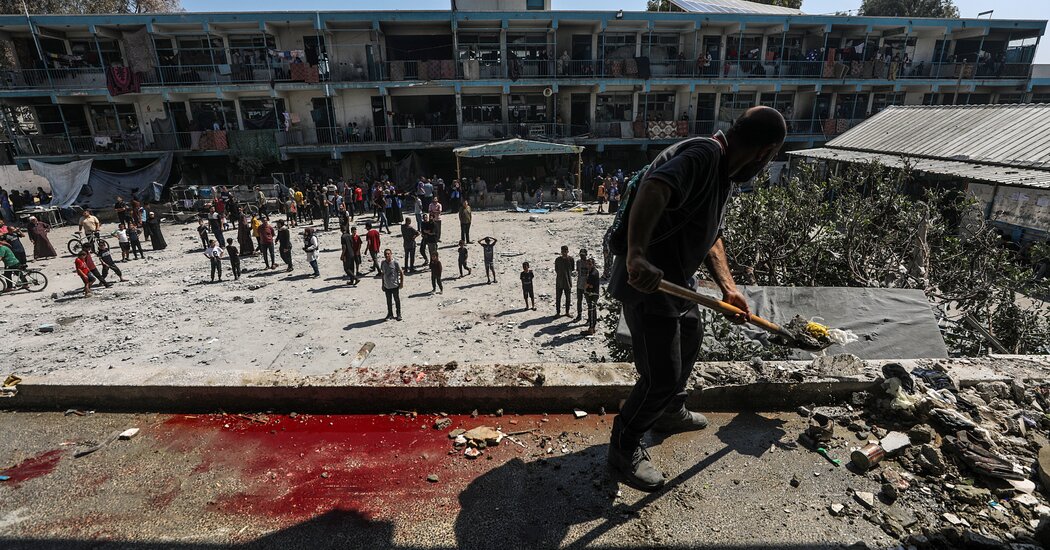At dawn Thursday, Haitham Abu Ammar searched the rubble of the school that has become a shelter for him and thousands of other displaced Gazans. For hours, he helped people piece together the body parts of their loved ones.
“The most painful thing I've ever experienced was picking up those pieces of meat with my hands,” said construction worker Abu Amar, 27. “I never thought I would do something like this.”
An Israeli airstrike hit the school complex early Thursday, killing dozens of people, including at least nine militants, the Israeli military said.
That day, bodies and mutilated limbs pulled from the rubble were wrapped in blankets, piled in the back of trucks and transported to Al-Aqsa Martyrs Hospital, the last large medical facility still in operation in central Gaza.
The Israeli military said the airstrike was carefully planned. Rear Admiral Daniel Hagari told reporters that Israeli troops had tracked the militants in the school-turned-shelter for three days before opening fire.
“The Israeli military and the Shin Bet found a solution to separate the terrorists from the asylum seekers,” he said.
But accounts from local and foreign medical staff, as well as interviews with hospitals conducted by The New York Times on Thursday afternoon, made it clear that civilians also died.
Outside the hospital morgue, people gathered to weep and pray for the dead. Hospital corridors were filled with people asking for help, or at least a little comfort.
A little girl with blood on her legs screamed “Mommy! Mommy!” as her sobbing mother followed her through the hospital corridor.
Gaza's Health Ministry said the attack on the school building, where thousands had sought shelter, killed at least 40 people, including 14 children and nine women. However, the ministry did not distinguish between the deaths of civilians and fighters, and neither side's claims could be independently verified.
Al-Aqsa Martyrs Hospital symbolizes not only the massive loss of life in central Gaza, but also the growing desperation among Gazans in their search for a safe place.
In recent weeks, the area has been flooded with people fleeing another Israeli offensive, this time targeting the southern city of Rafah, which was the main refuge for civilians before the offensive began and at one point housed more than half of the population of the Gaza Strip.
Then on Wednesday, Israel announced it had begun a new operation against Hamas militants in central Gaza — where many Gazans fleeing Rafah have ended up.
The attack on the school complex, which is managed by the United Nations Relief and Works Agency for Palestine Refugees in the Near East (UNRWA), the main UN aid agency for Palestine in Gaza, took place at around 2 a.m. the next day.
The schools have been used to shelter Gazans forced from their homes by the fighting since Israel launched an offensive on Gaza in October in retaliation for Hamas-led attacks on Israel. Israel says Hamas hides its forces in civilian sites such as schools or hospitals, a charge the group denies.
Health workers say 140 people have been killed and hundreds injured inside the Al-Aqsa Mosque in new military operations over the past two days.
“It's chaos here, the number of casualties is increasing, but the medical supplies for treatment are getting less and less,” said Karin Hust, a nurse with the international aid group Doctors Without Borders who works at the hospital.
During a visit to Al-Aqsa Mosque by The New York Times, medical staff could be seen pushing through panicked crowds trying to get into operating rooms, but operations were delayed by the crowds. In the chaos, medical staff sometimes brought people with mortal injuries into operating rooms, wasting precious time for those who still had a chance of survival, Ms. Hurst said.
Ms Hurst said most of the patients she has treated over the past few days have been women and children.
Mr Abu Amar was at the hospital again early Thursday afternoon after burying his friend who was rescued from the rubble of the school.
This time, he was caught with his friend's brother, who had been scratched in the face by shrapnel and a deep wound on his right leg, and he tried to push his friend into a corridor near the entrance.
But he's not the only one in desperate need of help.
All around them were wounded people, some lying on the ground, bleeding, others in their beds, calling for help. One man, his face blackened by burns and dust from the morning explosion, pleaded with two relatives who were with him to fan him with the cardboard they were waving.
The scene in the morgue for the dead was almost as chaotic as for the living. Corpses were everywhere, and relatives gathered around them, crying and screaming. The smell of blood was unbearable.
Outside the morgue, people came and went as bodies were wrapped in blankets (shrouds were in short supply) and loaded onto pickup trucks for burial. Friends and family lined up to pray before the bodies were taken away. Even passersby on the street stopped to join in the prayers.
“When is too much?” Ms. Hurst said. “I don’t know how to put it in a way that would shock people. What is wrong with humanity?”









